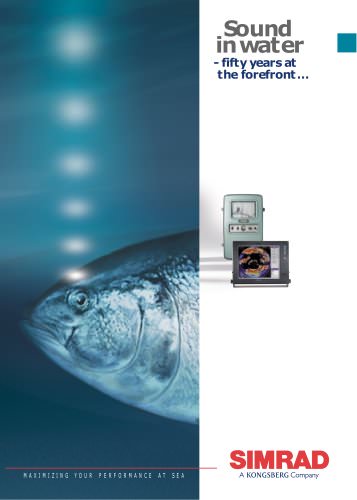
Catalog excerpts

Single Beam Systems SIMRAD TECHNOLOGY FOR SUSTAINABLE FISHERIES
Open the catalog to page 1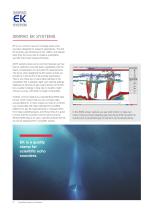
EK is our common name for all single beam echo sounders designed for research applications. The first EK sounder was introduced in the 1960’s, and already back then the focus was to create a quantitative sounder that could measure biomass. All EK systems share some common features such as built-in calibration and split beam capabilities with full beam compensation for accurate TS measurements. The focus when designing the EK system is that you should be in full control of all sounder parameters. That is why there are no automated settings in the acquisition SW. A skipper might want optimal...
Open the catalog to page 2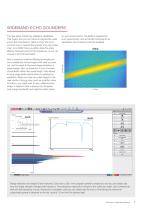
WIDEBAND ECHO SOUNDERS The new series of EKs has wideband capabilities. That means that you can transmit a signal that varies across the transmission, called a chirp. The most common way to operate the sounder is to use a linear chirp. In an EK80 chirp you either utilize the entire effective frequency band of the transducer, or you can choose to limit the bandwidth. for such environments. The EK80 is prepared for such requirements, and as the SW continues to be developed, new functions would be available. Due to advanced matched filtering techniques you can correlate the returned signal...
Open the catalog to page 3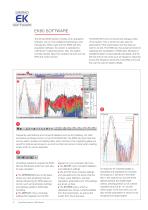
EK80 SOFTWARE The Simrad EK80 system consists of an acquisition software, one or more wideband transceivers, and transducers. When used with the EK80 real time acquisition software, the system is operated by a Windows™ based processor. Also, the system normaly requires input from auxiliary sensors such as GPS and motion sensor. The EK80 SW is the command and storage centre of the system. This is where the user sets the parameters of the transmission and the data you want to record. The EK80 also has advanced tools for replaying and visualization of RAW data. Biomass in predefined layers is...
Open the catalog to page 4
WIDEBAND TRANSCEIVER (WBT) The Wideband Transceiver is designed for applications where performance is the top priority. The WBT has four 500 W channels that can either work independently with single beam transducers, or together with a split beam transducer. The WBT is optimized for applications where power consumption and size is not critical, typically on board a research vessel or a platform with power and and high speed Ethernet communication available. The WBT transceiver is capable of operating on entire band from 10 kHz to 500 kHz, only limited by the transducer's bandwidth. WBT MINI...
Open the catalog to page 5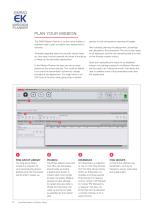
The EK80 Mission Planner is, as the name implies, a software used to plan a mission from deployment to recovery. All details regarding when the sounder should wake up, how long it should transmit and when it should go to sleep can be set before deployment. In the Mission Planner the user can set as many phases as the survey requires. This could be helpful if you want the transmission scheme to change throughout the deployment. You might want to do CW most of the time, while doing chirp in shorter periods to look at frequency response of targets. After carefully planning the deployment, all...
Open the catalog to page 6
The EK Wideband Autonomous Transceiver is made for applications where it is necessary to gather scientific data from other platforms than traditional research vessels. Typically this involve long term monitoring or monitoring in places where it would not be pratical, or in some cases not even possible, to use a research vessel. As the WBAT has a standard depth rating of 1500 meter, it can also be used to profile layers in depths where hull mounted echo sounders cannot reach with high frequencies. An autonomous EK system consists of an autonomous transceiver, one or more transducers, and a...
Open the catalog to page 7
All Simrad echo sounders should be calibrated in field by the user at regular intervals. Above all, calibration is required to collect quantitative data. There is however another good reason why you should calibrate your system frequently. A calibration is your best insurance that the system is working as expected. If a connection is unstable, or a channel in your transducer has malfunctioned, you will know instantly. With the introduction of chirp you introduce new challenges around calibration, as both the frequency and the beamwidth change during transmission. The EK80 SW has the...
Open the catalog to page 8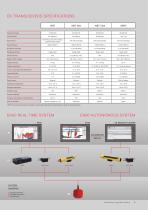
*WBT tube has two transceivers available. Consumption and power requirements are given for one transceiver. SYSTEM DIAGRAM Specifications | Single Beam Systems 9
Open the catalog to page 9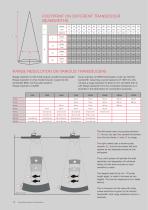
FOOTPRINT ON DIFFERENT TRANSDUCER BEAMWIDTHS A Range resolution in CW mode is given as half the pulse length. Range resolution in chirp mode however, is given by the bandwidth (BW), not the pulse duration: Range resolution=c/2xBW As an example, an EK80 transmission could use 100 kHz bandwidth. Assuming a sound speed (c) of 1500 m/s, this will give a range resolution of about 8 mm, far better than in CW. Range resolution from the composite transducers is in brackets in the table below for comparative purposes. The left vessel uses a long pulse duration (C). As you can see, this causes the...
Open the catalog to page 10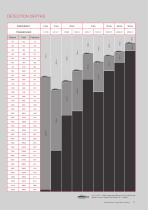
Note: For TS = -32dB in salt water 35ppt and 10° C at 38 kHz this relates to a cod of length 60cm. Bottom Sb = -30dB/m2 Specifications | Single Beam Systems 11
Open the catalog to page 11All Simrad catalogs and brochures
-
General Catalog
84 Pages
-
Catch Monitoring Systems
16 Pages
-
Sonars
12 Pages
-
Multibeam systems
12 Pages
-
Product catalogue
84 Pages
-
Echosounders
8 Pages
-
Simrad main product catalogue
43 Pages
-
Simrad scientific systems
8 Pages
-
Simrad SH90
4 Pages
-
ES200-7C
2 Pages
-
ES70-18CD
4 Pages
-
Software release note
2 Pages
Archived catalogs
-
SIMRAD CATALOGUE
36 Pages
-
FS70 Trawl Sonar
2 Pages
-
SIMRAD Catlogue
36 Pages
-
Sonar brochures
22 Pages
-
Echo sounder brochures
36 Pages
-
Catch monitoring brochures
68 Pages
















